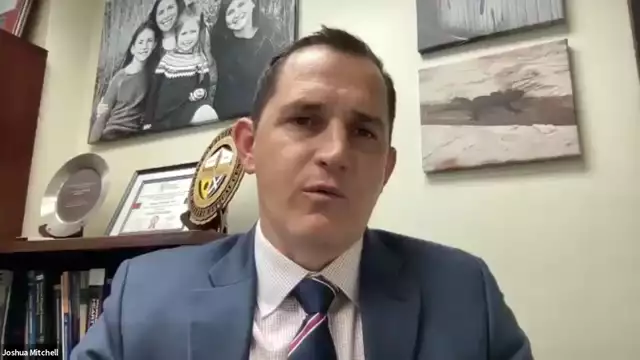Joshua D. Mitchell, MD- @JoshMitchellMD @Dr_Daniel_Cehic @CarmenBergom @ICOSociety #CardioONC #CardioOncology #Cardio...
Joshua D. Mitchell, MD from Washington University in St. Louis speaks about Cardiovascular Manifestations From Therapeutic Radiation: A Multidisciplinary Expert Consensus Statement From the International Cardio-Oncology Society.
Link to Abstract-
https://www.jacc.org/doi/10.1016/j.jaccao.2021.06.003
Abstract
Radiation therapy is a cornerstone of cancer treatment, with more than half of patients receiving it. As a result of increased use and survival, researchers are paying more attention to the long-term effects of ionizing radiation, including cardiovascular damage. Radiation therapy can cause vascular atherosclerosis, as well as valve, cardiac, and pericardial dysfunction. The International Cardio-Oncology Society has issued a consensus statement based on broad principles of radiation treatment, cardiovascular risk assessment, and risk mitigation in this population. Anatomically based suggestions for cardiovascular management and follow-up are offered, with a focus on the early detection of atherosclerotic vascular disease on imaging to aid in the development of preventative medication. Radiation-induced cardiovascular disease has its own set of management issues, which are discussed as well. The diverse expert panel's recommendations are based on the most recent literature and constitute a unanimous consensus.
Highlights
• Radiation therapy causes valvular, myocardial, and pericardial illness, as well as other short- and long-term cardiovascular side effects in the vasculature and heart.
• Computed tomography scans used for radiation planning or cancer staging can be used to diagnose asymptomatic atherosclerosis and target preventive treatments.
• Additional practical cardiovascular disease screening suggestions based on anatomical exposure are offered.
• Radiation-induced cardiovascular disease requires special considerations, and modern percutaneous therapy is frequently favored over surgical methods.
Introduction
Since its first use in 1899, therapeutic radiation has become a cornerstone of cancer treatment, with more than half of cancer patients now receiving it (RT). RT has both short- and long-term side effects, despite its good impact on cancer outcomes and survival. RT has been related to an increased risk of long-term unfavorable cardiovascular (CV) consequences, which can lead to higher morbidity and death in cancer survivors, according to research (1-3).
Radiation-induced CV disease has a wide range of symptoms. Vascular illness (including coronary artery disease [CAD] and subclavian artery stenosis), valvular disease, constrictive pericarditis, restrictive cardiomyopathy, and heart failure (HF) are all considerably enhanced after thoracic RT. (Central Illustration). Patients are also at a greater risk of carotid artery stenosis and cerebrovascular accidents after head and neck or whole brain RT. Aorto-iliac atherosclerosis and renal artery stenosis are possible side effects of abdominal or pelvic RT. Deoxyribonucleic acid damage, oxidative stress, and the release of inflammatory and profibrotic cytokines all play a role in radiation-induced CV illness, leading to vascular, myocardial, valvular, and pericardial fibrosis.
In light of the entire context of RT benefits and hazards, doctors must be aware of CV problems and implement appropriate screening, mitigation, and prevention techniques into their practice. Although there are guidelines and expert consensus statements for detecting RT-related heart damage and dysfunction , there are few screening recommendations for extracardiac vascular symptoms. Furthermore, screening criteria for thoracic RT survivors have concentrated on the detection of obstructive CAD rather than nonobstructive CAD. This narrow focus overlooks the risk of myocardial infarction in patients with nonobstructive CAD and the importance of early medical intervention in these patients . Furthermore, newer imaging modalities such as coronary artery calcium (CAC) screening and coronary computed tomography (CT) angiography, which can more thoroughly identify a patient's CV risk during and after RT, are not included in current guidelines .
The current International Cardio-Oncology Society consensus statement systematically reviews available data and provides comprehensive recommendations for preventing, screening, diagnosing, and managing CV disease in cancer survivors receiving or who have received RT to the head and neck, chest, abdomen, and pelvis. This document discusses fundamental concepts for preventing CV illness following radiation therapy and offers recommendations for detecting specific vascular effects based on anatomical location.
The International Cardio-Oncology Society was founded in October 2019 as an international, multidisciplinary collaboration of professionals in medical oncology, radiation oncology, cardiovascular imaging, and cardio-oncology. A comprehensive literature analysis was conducted by searching the PubMed index for studies published in English from 1975 to the present, combining text words and Medical Subject Headings such as radiation, cardiotoxicity, and CV anomalies; the final search yielded 2,999 publications. The literature evaluation was completed in October 2019 and then revised before the recommendations were finalized in December 2020. We also looked for relevant titles in the references of the publications we reviewed. Evidence from randomized controlled trials or meta-analyses was given top priority, followed by well-designed nonrandomized research, other nonrandomized studies, expert opinion, and clinical experience. ClinicalTrials.gov was also used to look for any relevant clinical trials.
To study the material and provide practical recommendations, the committee met bimonthly via webinars and teleconferences. Recommendations are tagged with language like "is advised," "may be useful," and "can be considered," according to American College of Cardiology/American Heart Association consensus statements (18). Because there are few randomized controlled trials particularly designed to address CV disease in RT survivors, no levels of evidence are provided. These proposals are the result of a consensus among the members of the multidisciplinary expert committee.




